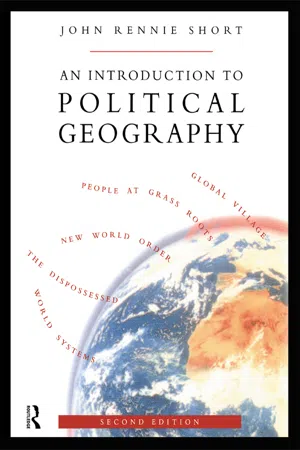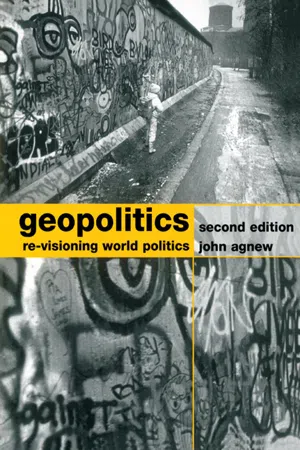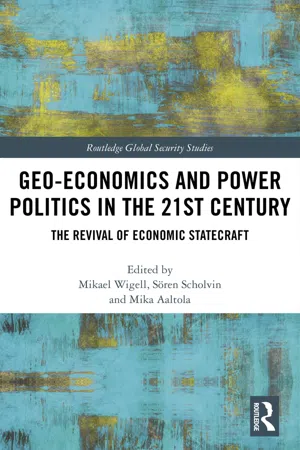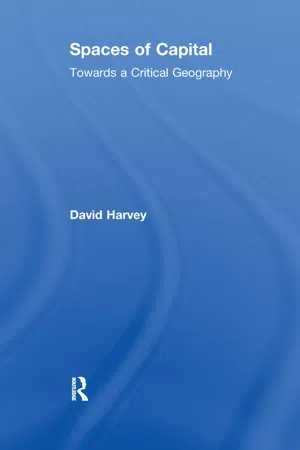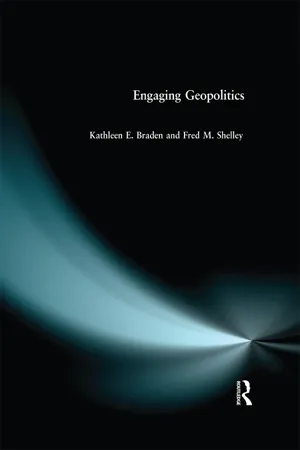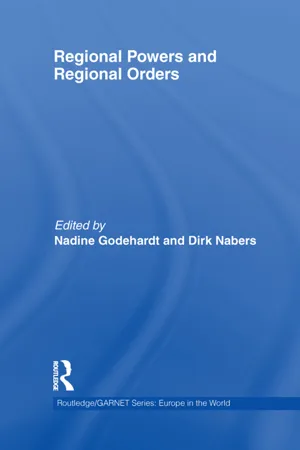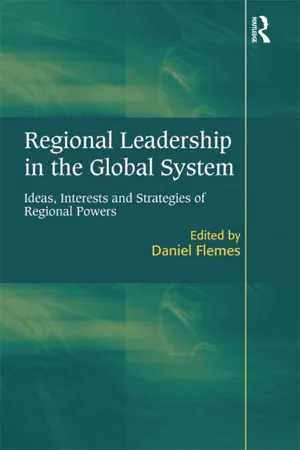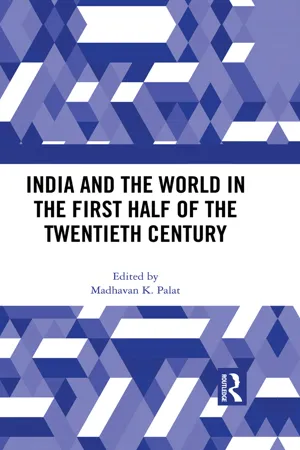Geography
Superpowers of the World
"Superpowers of the World" refers to the most influential and powerful countries on the global stage. These nations possess significant economic, military, and political influence, allowing them to shape international affairs and policies. The term is often used to describe countries such as the United States, China, Russia, and the European Union, which exert substantial impact on the world's geopolitical landscape.
Written by Perlego with AI-assistance
Related key terms
Related key terms
1 of 4
Related key terms
1 of 3
10 Key excerpts on "Superpowers of the World"
- eBook - ePub
- John Rennie Short(Author)
- 2002(Publication Date)
- Routledge(Publisher)
They achieve their status through economic power, military might and political influence. Their aim is to incorporate as much of the world as possible into their sphere of influence. Spheres of influence can be defined as the territory in which a superpower can wield effective power. What makes a superpower is the size of the sphere and the degree of influence. Influence is the ability to reach a desirable outcome. For example, the USA does not want to see a socialist state established in the Western Hemisphere. With the notable exception of Cuba it has been very successful in this goal. This has been achieved by diplomacy, flexing of economic muscles (e.g. refusing aid or trade, imposing embargoes) and military involvement, either direct or indirect. After the leftist revolution in Nicaragua in 1979, for example, the US government stopped aid to that country in 1981, imposed a trade embargo in 1985 and aided anti-government forces, the contras. The ultimate power of a superpower is to influence events without even trying. In Central and Latin America, for example, all politicians know that the establishment of a socialist society would be frowned on by the USA, which would exercise its power to stifle the change. This is so much part of the political reality that it often militates against such change. The sphere of influence of a superpower does not stretch evenly throughout the world. Most superpowers have a home base, which could cover either all or only a part of the state territory. In the USA it covers all the country, but in the USSR it was centred on the ethnic Russians. Then there are core area(s) of control in which one superpower reigns supreme and, finally, peripheral zones of competing power. Superpowers attempt to maintain and improve their geopolitical position by extending their relative spheres of influence - eBook - ePub
Geopolitics
Re-Visioning World Politics
- John Agnew(Author)
- 2004(Publication Date)
- Routledge(Publisher)
4 A World of Territorial StatesIn the modern geopolitical imagination, power has been defined as the ability to make others do something you desire and, at least from the nineteenth century onwards, it has been exclusively associated with territorial states that are usually presumed to be nation-states (ones where there is a close match between membership of a distinctive nation and the boundaries of a particular state). In this chapter I want to explore these contentions in some detail and to show how the spatiality or geographical organization of power is not necessarily tied for all time and all places to the territoriality of states. The state-centred account of spatiality of power, what I term the ‘territorial trap’, is the historical projection of a world in which power over others is envisioned as pooled up in the hands of equivalent units of territorial sovereignty, usually the most important states militarily, the so-called Great Powers.Most explicit in the case of political geography and the study of international relations, but common throughout the contemporary social sciences, the conventional understanding of the geography of power is underpinned by three geographical assumptions: first, that states have an exclusive power within their territories as represented by the concept of sovereignty; second, that ‘domestic’ and ‘foreign’ affairs are essentially separate realms in which different rules obtain; and finally, that the boundaries of the state define the boundaries of society such that the latter is totally contained by the former. These assumptions reinforce one another to produce a state-centred view of power in which the space occupied by states is seen as fixed, as if for all time. Thinking about the spatiality of power is thus put beyond history by assuming an essential state-territoriality to the workings of power. - eBook - ePub
Geo-economics and Power Politics in the 21st Century
The Revival of Economic Statecraft
- Mikael Wigell, Sören Scholvin, Mika Aaltola, Mikael Wigell, Sören Scholvin, Mika Aaltola(Authors)
- 2018(Publication Date)
- Routledge(Publisher)
The Geographical Pivot of History (1904), Mackinder touched upon a central anxiety of international politics: the fear that Eurasia’s massive territory and resources could be organised under the control of a single continental power, which would be in a position to project power and influence globally, unmatched by sea powers. Mackinder foresaw three potential candidates well positioned for redrawing that geopolitical balance of power: Germany, Russia and China. He argued that a Chinese expansion towards Eurasia’s heartland ‘would add an oceanic frontage to the resources of the great continent, an advantage as yet denied to the Russian tenant of the pivot region’ (1904, p. 437). Kaplan (2017) and Nye (2017), among others, have recently restated this idea.Geo-economic power projection results from the available economic capabilities of a state. Economic power provides geostrategic leverage in the context of economic interdependences among countries. Economic power is based on three components: markets, resources, and rules that shape international economic interaction. Relevant features of markets are the economic weight of the respective state and its growth expectations, market access, international flows of investment and trade, and resulting interdependences. Resources cover the access to and control of financial, natural, and technological resources. Rules refer to the ability to shape the institutions and regimes that define the international economic order. In different compositions, these components are the fundament of different forms of power, ranging from financial and investment power to resource-supplying power to sanctioning power. Geostrategic competition among great powers is at play whenever such forms of economic power refer to a geographically defined objective – shaping the Asia-Pacific region through a new set of rules, for instance. To avoid a common misunderstanding: although economic diplomacy and economic statecraft are essential for successful geo-economics, they are not identical. Economic diplomacy and economic statecraft lack a geographical dimension.2The term geo-economics gained notoriety with a publication by the geostrategist Edward Luttwak in 1990. His article From Geopolitics to Geo-economics - eBook - ePub
Spaces of Capital
Towards a Critical Geography
- David Harvey(Author)
- 2002(Publication Date)
- Routledge(Publisher)
Geopolitical struggles between territories and regions have therefore been of considerable importance in geographical understandings. The division of the world into distinctive spheres of influence by the main capitalist powers at the end of the nineteenth century, for example, raised serious geopolitical issues. The struggle for control over access to raw materials, labor supplies and markets was a struggle for command over territory. Geographers like Friedrich Ratzel and Sir Halford Mackinder confronted the question of the political ordering of space and its consequences head on, but did so from the standpoint of survival, control and domination. They sought to define useful geographical strategies in the context of political, economic and military struggles between the major capitalist powers, or against peoples resisting the incursions of empire or neocolonial domination. This line of work reached its nadir with Karl Haushofer, the German geopolitician, who actively supported and helped shape Nazi expansionist struggles. But geopolitical thinking continues to be fundamental within the contemporary era particularly in the pentagons of military power and amongst those concerned with foreign policy. By force of historical circumstance, all national liberation movements must also define themselves geopolitically if they are to succeed, turning the geography of liberation into geopolitical struggles.But it is not only the interactions between geographical entities that need to be treated in a dynamic way. The processes of region formation are perpetually in flux as social and natural processes reconfigure the earth’s surface and its spatially-distributed qualities. New urban regions form rapidly as urban growth accelerates, climate change generates shifts in biotic conditions, water regimes, and the like. Populations shift their perceptions and allegiances, reinvent traditions and declare new regional formations or radically transform the qualitative attributes of the old. Like space-time and the cartographic imagination, the dynamics of the process are by far the most interesting. - eBook - ePub
- Kathleen Braden, F.M. Shelley(Authors)
- 2014(Publication Date)
- Routledge(Publisher)
2Fundamental Concepts of Geopolitics
KEYWORDS
geography, nation, state, sovereignty, boundaries, territory, heartlandKEY PROPOSITIONS
• Geopolitics focuses on the geographical perspective of international relations.• The distinction between nation and state is crucial to understand and analyze many international conflicts.• There is a close relationship between power and territory at all geographic scales, sometimes leading to conflict over territorial control.• Geopolitics as a discipline has been influenced by British, French, German, American, and Russian theories.Geopolitics is the study of international relations and conflicts from a geographical perspective. The geographical perspective suggests that location, distance, and the distribution of natural and human resources have significant influences on international relations. Thus we begin our investigation of geopolitics by focusing on the unique perspective of the geographer. We then investigate several key geopolitical concepts: the nation, the state, power, territory and conflict.2.1 The geographical perspective
Geography is the systematic study of location and place. Professional geographers address questions concerning where and why various phenomena are located and distributed. In addition, they examine and compare the unique characteristics of places while considering the relationships between individual places and the global economy.What distinguishes contemporary geography from other approaches to knowledge is not content, but intellectual approach. None of the vast number of subjects analyzed by professional geographers are unique to the discipline of geography. Geography is distinguished from these disciplines by its unique, holistic and integrative approach to knowledge. The geographer pulls together knowledge of social, economic, political, cultural and environmental forces that shape human activity in places and regions throughout the world. - eBook - ePub
- Nadine Godehardt, Dirk Nabers(Authors)
- 2011(Publication Date)
- Routledge(Publisher)
Size alone (of a country or of a company) is not adequate; also necessary are ‘intelligence, readiness to respond, and efficiency in translating decisions into action’ (Kindleberger 1970 : 56). Based on this, Kindleberger defines power as follows: ‘Power is the strength plus the capacity to use it effectively’ (Kindleberger 1970 : 65). According to Kindleberger, the exercise of power includes a nation’s display of economic productivity and mobility. The advantage for the leadership is being the first to enjoy the fruits of research, which in turn gives the leader the capacity to transform. Kindleberger’s contribution on regional power is therefore characterized by the terms public goods and capacity to transform, with which the relational dynamics of these interconnections are highlighted. Susan Strange (1975) bases her structural power concept on the heterodox perspective of international political economy. She assumes the power of states and the role of transnationally active Non-Governmental Organizations. According to her concept, economic power is exercised on four levels (Strange 1975 : 222). Rich countries and their governments influence the structure of the global economy through the pattern of their investments, production, trade and consumption. They establish the framework for minimum standards for the maintenance of stability, order and law in the global market economy. National governments exercise economic power through the formulation of national laws (for factors of production, credit and markets). The government with the biggest domestic market and the largest number of multinational businesses (that are important in the driving of global production) possesses the greatest economic power. Buyers and sellers, creditors, and debtors affect economic transactions at the operational level. Economic power is thus always the result of a bargaining process; that is, it is relational. Technology and hegemony According to Richard R - eBook - ePub
Regional Leadership in the Global System
Ideas, Interests and Strategies of Regional Powers
- Daniel Flemes(Author)
- 2016(Publication Date)
- Routledge(Publisher)
Equally, and as the chapters in this volume illustrate so clearly, almost all of the classical issues surrounding the notion of power arise when we consider the nature of the ‘power’ that regional powers are supposed to enjoy and that they seek to deploy or exert within their regions. Power is an essentially contested concept in that it is subject to the kind of debate that is not rationally resolvable. Differing interpretations result from differing moral and political priorities and commitments. There is no overarching theory of social power and no single analytical approach that provides the magic key. As with regions, there is a natural tendency to look for measures of material capabilities in the identification of regional powers. Material capabilities clearly matter and much of this writing is extremely valuable. But it has its limits, particular in so far as it underplays the multi-dimensional character of power (Barnett/Duvall 2004), and forgets some of the basic lessons of social power analysis. The first is the importance of context. To paraphrase Dahl (1957): “When you hear that country x is an influential regional power, the proper question is: Influential over what actors, in what period, with respect to what matters?” The second lesson is still more important. Discussion of power and influence cannot be separated from the analysis of motives and values. It may be true that all states, including regional powers, seek power and security, but the real question is: what sorts of power do they seek and for what purposes? Third, power is relational and great attention has to be paid to the reception of all attempts at exercising power and to the successful cultivation of ‘followership’. And, finally, power is structural. The analysis of power within any particular domain has to be alert to the way in which that domain is embedded within broader material and ideational structures.It is this last consideration that connects with the theme of this chapter, namely the relationship between the global and the regional, between the one world of the global political, economic and social system, and the many worlds of different regions and sub-regions. In this chapter 1 - Madhavan K. Palat(Author)
- 2017(Publication Date)
- Routledge India(Publisher)
The world has been truly globalised, fused into a single space for power, far from united, highly differentiated, yet free of the binaries of the Cold War or the territorial power blocs or Grossraums competing for supremacy. The contestation of the kind witnessed in the two world wars has ended; the world is led from America, but not by the territorially defined American imperial state or a Western civilisation. Such a critique of geopolitics and of its recasting merges it with global power in its most generalised, anarchic, and perplexing forms and seems in effect to dissolve the concept of geopolitics. 147 It is not quite clear why we need continue with it; and Agnew has served notice: ‘This may well be an auspicious moment, therefore, to ask whether the modern geopolitical imagination, which lies at the root of all of these scenarios to one degree or another, is not itself overdue for retirement from the global scene.’ 148 Notes * I am most grateful to Mehrdad Samadzadeh of Toronto University for his considerable help with references. 1 Friedrich Ratzel, Anthropogeographie, Part 1, Grundzüge der Anwendung der Erdkunde auf die Geschichte, 3rd edn, Stuttgart: Engelhorn, 1909, pp. 148–151. 2 Nicholas J. Spykman, ‘Geography and Foreign Policy, I,’ The American Political Science Review, 1938, 32(1): 28–50; Nicholas J. Spykman, ‘Geography and Foreign Policy, II,’ The American Political Science Review, 1938, 32(2): 213–236; Nicholas John Spykman, America’s Strategy in World Politics: The United States and the Balance of Power, New York: Harcourt, Brace, 1942; Nicholas John Spykman, The Geography of the Peace, edited by Helen R. Nicholl, New York: Harcourt, Brace, 1944. 3 See, among others, Karl Haushofer, Weltpolitik von Heute, Berlin: Zeitgeshichte, 1935. 4 Halford J- eBook - ePub
Global Geopolitics
A Critical Introduction
- Klaus J. Dodds(Author)
- 2014(Publication Date)
- Routledge(Publisher)
Politics Among Nations listed the six major principles of political realism (Morgenthau 1948). It has been argued that the implicit assumptions of traditional political geography have been inspired by realist thought: ‘As it informs a rather large and influential literature on geopolitics and military affairs, for example, realism has often degenerated into little more than an apolitical apology for cynicism and physical force’ (Walker 1993: 107). Peter Taylor has argued that traditional geopolitical thinking in the mode of Mackinder and Mahan was inspired by a tradition of power politics within international relations (Taylor 1993). Mackinder’s model of competing land and sea powers was inspired by his commitment to promoting British imperial interests in the face of overseas competition from Germany and Russia. The development of railways was considered crucial to the balance of power between imperial nations because it would allow traditional land-based powers such as Russia to control vast land areas through speed of travel. The identification of the Euroasian landmass as a ‘geographical pivot of history’ pointed to the geopolitical significance of particular territories in the struggle for control over the earth’s surface.Traditional geopolitics has also been underwritten by many of the assumptions of political realism concerning the nature of the international arena and the significance of state sovereignty and national interests. In contrast to realist analysis of international politics, however, political geography and geopolitics have focused on the power of the land and the sea to shape international relations. Classical geopolitical writers such as Mackinder endowed the ‘Heartland’ with the potential to influence world politics at the expense of the so-called rimlands and outer crescents. Fixed assumptions about the geographical significance of places littered the geopolitical discourses of European and American political geographers. Geographical divisions were considered timeless and thus immune to human alteration. As the American political scientist Ladis Kristof once argued: ‘The modern geopolitician does not look at the world map in order to find out what nature compels us to do but what nature advises us to do, given our preferences’ (Kristof 1960: 19). The capacity of human observers to influence understandings of world politics was diminished when the meaning of place and region was considered static rather than capable of change. Geography was reduced to the role of simply providing a territorial stage on which the interactions of states unfolded. Recent work within political geography has suggested that this is a very restricted view of geography which ignores how and why geographic spaces and places are made significant through the processes of discursive construction. - eBook - ePub
- Geoffrey Sloan(Author)
- 2017(Publication Date)
- Routledge(Publisher)
Geopolitical methods point toward the description of the constellation of forces which exist or existed at a particular time and within a particular geographical context. Geopolitical theories may suggest contemporary and even future significance of the various forces as they play out across specific locations and contexts; they juxtapose the enduring with the ephemeral thereby providing a way of explaining past change and predicting future developments. 144 An important caveat is that any theory has its limitations: ‘Although theory is never complete and is always bound to be at least somewhat wrong, it performs several very useful functions when it defines, categorizes, explains, connects and anticipates.’ 145 Geopolitical political theories need to be applied to relevant case studies for the efficacy of the theories to be evaluated. One result of this intellectual exercise will be a more systematic explanation as to why policy makers were both successful and unsuccessful in bringing about changes in the geographic scope of their policy objectives. The case studies will utilize a number of different geographical contexts. They will draw attention to an idiographic perspective which has a focus on differences rather than sameness: The military effects of actual situations primarily depend on the level of military technology, the characteristics and distribution of military forces, the missions of these forces, and the geographic characteristics of the area involved
Index pages curate the most relevant extracts from our library of academic textbooks. They’ve been created using an in-house natural language model (NLM), each adding context and meaning to key research topics.
Explore more topic indexes
Explore more topic indexes
1 of 6
Explore more topic indexes
1 of 4
